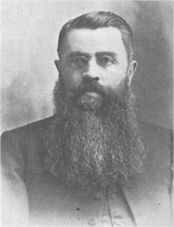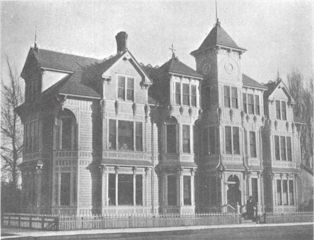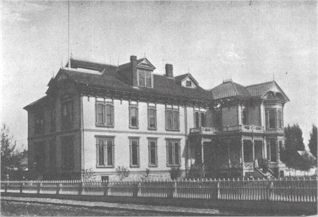|
St. Francis Church Written in 1898
The historical development of the Catholic parish of Baker City, is analogous to that of the town itself. Time with its vicissitudes, and emigration with its attendant at fractions has molded it into the shape and proportion it has assumed today. It is interesting to take a retrospective view of events proceeding the present state of the parish. Starting in the year 1862, the reason for doing so being based upon the fact that the cradle of Baker City's Congregation was located even then at Auburn, 12 miles south west of here, where some 1500 men were located in the search of gold, a number of whom were Catholics. In November 1863, Father Meplie, a chaplain in the United States army, was placed in charge of them. Services were at first conducted in the residence of O. Mooney, but a year later a frame structure was put up by Messrs. W. H. Packwood, Sr., John J. Dooley and the late I. B. Bowen, for church purposes. An unexpected change occurred shortly after, the Boise Basin excitement scattered the maters of Auburn, and the present town site of Baker City having been laid out, and the county seat being removed to it, a large number of Auburn's inhabitants moved here and became the pioneers of Eastern Oregon's metropolis. At about this same Rev. Father L. It. Dieleman was put in charge of the Catholics residing in this section. He made his home in Canyon City, and from there earnestly endeavored to bring the consolations of religion to the scattered Catholics living in Eastern Oregon and Idaho. In this manner he visited Baker City repeatedly on has trips to and fro. There being no church edifice, services were held in different private residences. The number of Catholics keeping pace, however, with the progress of the town. The need of a church building was keenly felt. Dr. J. M. Boyd, now a resident of Spokane, made a start in this direction by donating a tract of had, comprising a whole block. J. W. Virtue, J. J. Dooley, I, B. Bowen, deceased. E. P. Cranston and others made liberal donations of cash with which a church building was erected au the fall of 1871. Rev. Father Dielman through whose moral influence the church was erected, not only officiated in it first, but also became the first pastor. In 1873 he was called away, and it ran into the following year before he was replaced by a steady pastor in the person of Rev. R. DeRoo. However neither the Catholics of Baker City, nor of the mission attached to the parish had been neglected, as from time to time Fathers Vermeesh, Verhaag, Orth and Bronsgeest came to attend to their wants. On Father De Roo's arrival he soon discovered that a pressing need existed for a parochial school, and after some endeavors, he succeeded in April, 1875, in obtaining four Sisters of the Holy Names from Portland. They held school and conducted an academy in the building, which was transformed last fall into the present St. Elizabeth's Hospital. They were succeeded in September 1885, by the Sisters of St. Francis, who have since built it new academy and created a hospital. In 1886 Father DeRoo went to Pendleton and was replaced by Father Charles Wensierski. This priest. however only remained until the following year, when he was succeeded by Rev. Father O. Heinrich, who had the good fortune to remain at the helm of the parish until 1893 when he was ordered to take charge of a parish in East Portland. After his departure Farther B. J. Beutgen administered to the parish until Father Verhaag became its rector. He, and the largest number of the parishioners were old acquaintances, as he had repeatedly visited them, and even in 1883 had charge of the parish for a short time. Immediately upon his arrival he was confronted with the want of room as the seating capacity of the old church had grown too small. He deliberated on what to do, whether to start a new structure or transform the annex in the rear, which had been used as a residence for the pastor, into a sanctuary. Deciding on the latter, he soon had the change made and a new parish erected without hardening the congregation with a single debt. At present there are at least ninety families in the city limits in charge of Rev. Fathers Verhaag and Van Roc. The want of a larger place for worship is again keenly felt, and the erection of a new church building is under advisement. St. Elizabeth Hospital
The St. Elizabeth hospital, which was lately opened by the Sisters of St. Francis, occupies the large three-story building located on Church street, between First and Second. Like all institutions in their charge it is a model of neatness and cleanliness. On the ground floor, as the visitor enters, is the reception room on tile left, and on the right a complete pharmacy, presided over by a sister who has for years made a study of medicine. There is also a ward for ladies on this floor, as well as the dining room or refectory. On the floor above are several private rooms men's ward, and the surgical room, where operations are performed and on the next floor we find more private rooms, as well as those of the sisters', and a beautiful little chapel. The hospital has a complete heating apparatus placed within it; and the corridors where the patients walk and exercise are always warm and comfortable in the coldest weather, while in summer the long corridors running directly through the house permit of perfect ventilation and a constant change of atmosphere Seven sisters, including trained nurses arc connected with the institution, and in their ministrations of the sick they are most patient as they move about almost noiselessly, and many are the grateful praises for their tenderness by those whom they ease. The hospital has its own corps of physicians who are among the most eminent of the city, and includes Dr. Atwood, chief of staff. Dodson, McDaniel, Faull, Parker, Hayes and Snow. In a country where there are so many far removed from friends and relations, with no one to care for them where illness or physical disorder overtakes them. It is a plea sure to know that there is an institution of this kind when one may find a genuine home in the time of suffering and pain, where a kind hand is ever ready to smooth their sick pillow or a gentle voice ever man to breathe a word of hope and comfort. St. Francis Academy
There is no institution of which Baker City is more proud than St. Francis' Academy, conducted by the sisters of that name. It is today one of the most complete among the educational institutions of Eastern Oregon, and its patronage is by no means confined to Baker county but extends over the neighboring counties, also into Idaho. A visit to this seat of learning some days ago, elicited some facts regarding the institution and its work, which may be of interest to those who have not been there. Situated in the suburban portion of tile city, on a large tract of land owned by the sisters, the pupils have quiet and a sense of being at home in the very environs of this rapidly growing city. The sisters are enabled to have large playgrounds for the various divisions of the students. A tour of inspection through the building shows how orderly, neat and well-arrange are the different rooms of the Academy. Entering the institution by high steps in front, you are really in what is the second story of the building. On the ground floor is the kitchen, dining room, and large recreation room, used by the children in had weather, or when it is not desirable for them to play outside. On the floor above are tine parlors, office, four music rooms, three class-rooms, recitation room and library. On the third floor we find the chapel, children's and sisters' dormitories, etc., and in the attic are the boys' dormitories, studio and trunk rooms. The coarse of instruction is a most complete and comprehensive one, and no pains are spared to give the pupils at St. Francis' all the advantages of a first class education. The branches embrace the primary, secondary, preparatory, academic and collegiate departments, anti a graduate by passing the state examination is given a state diploma enabling them to teach for six years in any of the schools of the state, which can then be merged into it life diploma. Besides the ordinary studies, the languages, general vocal music and needle work are taught throughout the course. Private lessons in instrumental music, including piano, organ, banjo, violin, mandolin. zither and guitar, also painting and waxwork in all their branches, are given by competent instructors. The instruction given at St. Francis' is of the most thorough and practical character, as they train the heart as well as the mind, and intend to form noble men and women, who will go forth in the world loving only that which is beautiful, pure and good, and fitted for whatever duties life may impose. |
|




